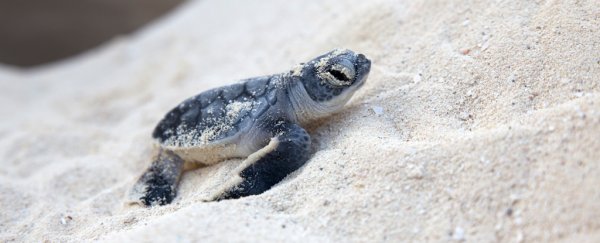A turtle hospital in Florida said all the turtles they tested for the past four years have been female, a worrying trend it attributes to climate change.
The temperature of the sand where the eggs are buried influences the sex of sea turtles.
Males are already a small minority of sea turtles – outnumbered around 10 to one – and as the sand gets hotter fewer and fewer males develop.
Experts disagree about the effect of this trend on the survival of sea turtle species. Regardless, climate change is putting heavy pressure on the endangered animals, an expert told Insider.
Female sea turtles are made in hot sand
"There are seven species of sea turtles, and all of them produce more females as it gets warmer," said Lucy Hawkes, an ecologist from the University of Exeter who has been studying the phenomenon since 2007.
"All of them have strongly female biased sex ratios," she said in an email to Insider.
Sea turtle eggs incubated in sand hotter than 88.8° Fahrenheit (31° Celsius) will be female, per the US National Oceanic and Atmospheric Administration (NOAA).
The past four summers have been the hottest on record, Bette Zirkelbach, manager of the Turtle Hospital in Marathon, a city in the Florida Keys, told Reuters.
"Scientists that are studying sea turtle hatchlings and eggs have found no boy sea turtles, so only female sea turtles for the past four years," she said.
The phenomenon has been observed around the world. A 2018 study found that 99 percent of turtles in Eastern Australia were female as well.
Running out of males?
Experts are split on what this could mean for the sea turtle populations.
Biologist David Owens, a professor emeritus at the College of Charleston told The Washington Post in 2018 that within a few decades to a century, "There will not be enough males in sea turtle populations."
Having fewer males could lead to unsustainably poor genetic diversity among sea turtles, Melissa Rosales Rodriguez, a sea turtle keeper from the Miami Zoo, told Reuters.
Hawkes, however, told Insider it's likely more complicated than that.
It's unclear what the "optimal" gender balance should be, she said.
It's common for a group of sea turtle nests to hatch about 90 percent females, and evidence suggests that only a few males are needed to fertilize all the eggs.
So it is possible, for instance, that "having lots of females could be an evolutionary adaptation to increase the population from being endangered," she said.
A few studies have also suggested that males could still be produced from a hot nest if the eggs are wet.
"If you ran out of all males, it would threaten the population – but we don't think that's going to happen too soon," she said.
Regardless, there's no denying that climate change is putting pressure on sea turtles.
It causes more storms, which can wipe out thousands of incubating nests in one go, and sea level rise that floods the nest and kills the eggs, she said.
"The biggest thing we can do in this regard is limit development of nesting beaches, so reduce the number of new hotels, etc. being built behind the beach," said Hawkes.
This article was originally published by Business Insider.
More from Business Insider:
